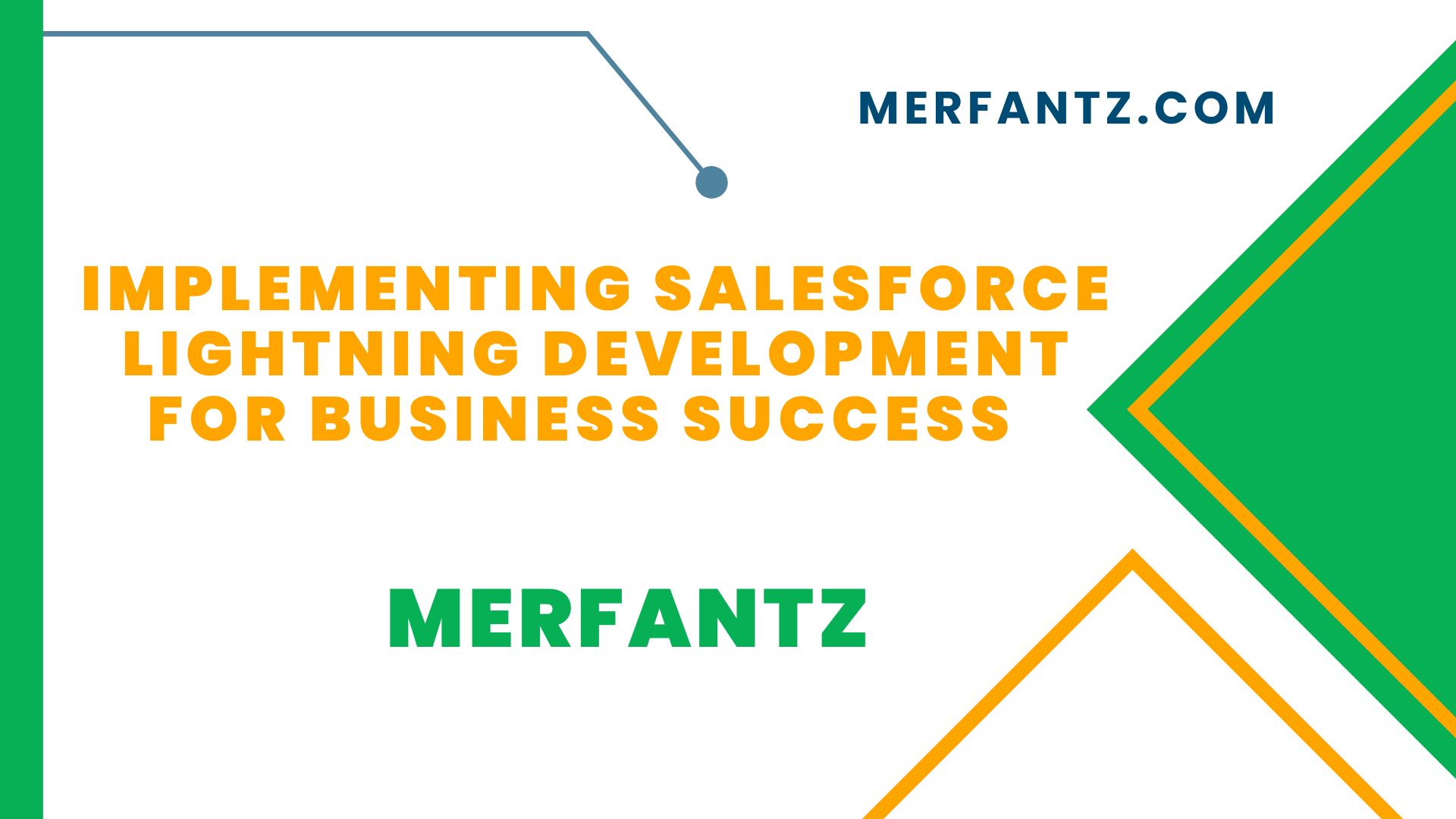Introduction to Salesforce Lightning Development
Salesforce Lightning Development is a powerful framework that enables businesses to enhance their Salesforce experience and drive success. It is a modern, intuitive platform that empowers organizations to build customized, feature-rich applications and streamline their business processes. With its user-friendly interface and extensive capabilities, Salesforce Lightning is revolutionizing the way businesses interact with their customers and manage their operations.
Understanding the Benefits of Salesforce Lightning for Businesses
Salesforce Lightning offers numerous benefits for businesses aiming to achieve greater efficiency and productivity. Firstly, it provides a highly responsive and visually appealing user interface, delivering a seamless user experience across devices. This translates into improved employee engagement and satisfaction, resulting in increased productivity and reduced training time.
Additionally, Salesforce Lightning’s advanced features, such as drag-and-drop functionality, enhanced reporting capabilities, and real-time collaboration, empower users to work smarter and make informed decisions. The platform also offers robust customization options, allowing businesses to tailor their Salesforce instance to their unique needs and workflows.
Key Features and Functionality of Salesforce Lightning
Salesforce Lightning encompasses a wide range of features and functionalities designed to optimize business processes and drive growth. Some key features include Lightning App Builder, which enables the creation of custom applications without writing code, and Lightning Components, reusable building blocks for developing dynamic and interactive interfaces.
Furthermore, Salesforce Lightning offers powerful automation capabilities through its Lightning Flow and Process Builder tools. These tools allow businesses to automate repetitive tasks, streamline workflows, and ensure consistent and efficient processes across the organization. The platform also integrates seamlessly with other Salesforce products, such as Sales Cloud and Service Cloud, providing a unified and comprehensive solution for sales, marketing, and customer service.
How Salesforce Lightning Boosts Business Productivity and Efficiency
By adopting Salesforce Lightning, businesses can significantly enhance their productivity and efficiency. The platform simplifies complex processes, eliminates manual tasks, and automates routine activities, enabling employees to focus on more strategic initiatives. With streamlined workflows and intuitive interfaces, users can complete tasks faster and make data-driven decisions more efficiently.
Moreover, Salesforce Lightning promotes collaboration and teamwork by providing real-time updates, shared dashboards, and collaborative tools. This fosters better communication and coordination within teams, leading to improved productivity and accelerated project timelines. Overall, Salesforce Lightning empowers businesses to optimize their operations, increase productivity, and achieve higher levels of efficiency.
Tailoring Salesforce Lightning to Your Business Needs
One of the greatest strengths of Salesforce Lightning is its flexibility and customization options. Businesses can tailor the platform to align with their unique processes and requirements, ensuring maximum value and efficiency. Salesforce Lightning allows users to create custom objects, fields, and workflows, as well as define business rules and automation.
With the Lightning App Builder, businesses can build customized applications specific to their industry or organizational needs, without the need for extensive coding knowledge. This empowers companies to create personalized experiences for their users and streamline workflows to match their specific business processes. Salesforce Lightning’s flexibility ensures that businesses can leverage the platform’s full potential and adapt it to their evolving needs.
Steps to Implement Salesforce Lightning Development
Implementing Salesforce Lightning Development involves a systematic approach to ensure a successful transition. The following steps outline the implementation process:
- Assess Business Needs: Evaluate the current Salesforce setup and identify pain points, inefficiencies, and areas for improvement.
- Plan and Design: Develop a comprehensive plan to migrate to Salesforce Lightning, including defining objectives, setting milestones, and creating a customized user interface.
- Configure and Customize: Customize Salesforce Lightning to match specific business requirements, including creating custom objects, fields, and workflows.
- Data Migration: Migrate existing data from the previous Salesforce instance to Salesforce Lightning, ensuring data integrity and consistency.
- User Training: Provide comprehensive training to employees to ensure a smooth transition and maximize user adoption.
- Test and Optimize: Conduct thorough testing of the Salesforce Lightning implementation to identify and resolve any issues or bugs. Continuously optimize the platform based on user feedback and evolving business needs.
Best Practices for a Successful Salesforce Lightning Deployment
To ensure a successful Salesforce Lightning deployment, consider the following best practices:
- User Involvement: Involve end-users throughout the implementation process to gather feedback, understand their needs, and ensure user adoption.
- Change Management: Develop a change management strategy to address potential resistance to change and ensure a smooth transition to Salesforce Lightning.
- Data Cleansing: Cleanse and standardize existing data before migrating to Salesforce Lightning to maintain data accuracy and quality.
- Customization Guidelines: Define customization guidelines and best practices to ensure consistency and scalability across the platform.
- Continuous Training and Support: Provide ongoing training and support to users to maximize their productivity and help them leverage Salesforce Lightning’s capabilities effectively.
Enhancing User Experience with Salesforce Lightning Components
Salesforce Lightning Components are reusable building blocks that enhance the user experience and allow for greater customization. These components can be easily dragged and dropped onto a page, enabling users to create dynamic and interactive interfaces without extensive coding.
With Salesforce Lightning Components, businesses can build intuitive dashboards, visually appealing forms, and interactive charts to present data in a meaningful and actionable way. These components promote a personalized user experience, enabling users to access relevant information quickly and make informed decisions. By leveraging Salesforce Lightning Components, businesses can create engaging interfaces that align with their brand and enhance user satisfaction.
Integrating Third-Party Apps with Salesforce Lightning
Salesforce Lightning offers seamless integration capabilities, allowing businesses to connect with a wide range of third-party applications. This integration enables businesses to leverage the functionality of other popular apps while keeping their data centralized within Salesforce.
By integrating third-party apps with Salesforce Lightning, businesses can automate data synchronization, streamline processes, and gain a holistic view of their operations. Whether it’s integrating with marketing automation tools, document management systems, or financial software, Salesforce Lightning provides a unified platform that brings together various applications, enhancing efficiency and productivity.
Measuring Success and ROI with Salesforce Lightning Adoption
Measuring the success and return on investment (ROI) of Salesforce Lightning adoption is crucial for businesses. Key performance indicators (KPIs) can help evaluate the impact of Salesforce Lightning on business outcomes. Some essential metrics to consider include increased user productivity, reduced manual effort, improved customer satisfaction, and enhanced sales and revenue.
Regularly monitor these KPIs and leverage Salesforce Lightning’s reporting and analytics capabilities to gain insights into the platform’s effectiveness. This data-driven approach allows businesses to make informed decisions, identify areas for improvement, and optimize their Salesforce Lightning implementation for continued success.
Frequently Asked Questions (FAQ)
What is Salesforce Lightning Development?
Salesforce Lightning Development is a framework and platform provided by Salesforce that enables businesses to create customized, feature-rich applications and enhance their Salesforce experience. It offers a modern and intuitive user interface, advanced automation capabilities, and seamless integration with other Salesforce products. Salesforce Lightning Development empowers businesses to streamline processes, increase productivity, and drive success.
How does Salesforce Lightning benefit businesses?
Salesforce Lightning offers several benefits to businesses. It provides a responsive and visually appealing user interface, resulting in improved user engagement and productivity. The platform enhances collaboration and teamwork through real-time updates and shared dashboards. Salesforce Lightning also enables businesses to customize and tailor the platform to their specific needs and workflows, ensuring maximum efficiency and value.
Can Salesforce Lightning be integrated with other applications?
Yes, Salesforce Lightning supports seamless integration with a wide range of third-party applications. This integration allows businesses to leverage the functionality of other popular apps while keeping their data centralized within Salesforce. By integrating third-party apps with Salesforce Lightning, businesses can automate data synchronization, streamline processes, and gain a holistic view of their operations.
What are some best practices for a successful Salesforce Lightning deployment?
To ensure a successful Salesforce Lightning deployment, it is recommended to involve end-users throughout the implementation process, develop a change management strategy, cleanse and standardize existing data, define customization guidelines, and provide continuous training and support to users. These best practices help maximize user adoption, maintain data integrity, ensure consistency, and optimize productivity.
What is the success rate of Salesforce implementation?
The success rate of Salesforce implementation varies depending on various factors such as the complexity of the project, level of user adoption, and effective change management strategies. However, Salesforce implementations generally have a high success rate due to the platform’s robust features, extensive support resources, and wide adoption across industries.
What are two advantages of using Salesforce Lightning?
Two advantages of using Salesforce Lightning are enhanced user experience and increased productivity. Salesforce Lightning offers a modern and intuitive user interface, providing a seamless and visually appealing experience for users. Additionally, Lightning’s advanced features and automation capabilities streamline workflows, automate tasks, and empower users to work more efficiently.
What’s a key benefit of Lightning apps for your users in Salesforce?
A: A key benefit of Lightning apps for users in Salesforce is the ability to create customized applications without extensive coding. Lightning apps empower users to build tailored applications specific to their needs, enhancing their productivity and allowing them to access relevant information quickly. This flexibility promotes a personalized user experience and ensures that users have the tools they need to accomplish their tasks effectively.
What is the benefit of the Lightning Component framework in Salesforce?
The Lightning Component framework in Salesforce offers several benefits. It provides reusable building blocks that enable developers to create dynamic and interactive interfaces with ease. These components enhance the user experience, promote consistency across applications, and significantly reduce development time. The Lightning Component framework also facilitates the creation of scalable and customizable applications, empowering businesses to meet their unique requirements and adapt to changing needs efficiently.
Conclusion
Implementing Salesforce Lightning Development can bring significant benefits to businesses, enhancing productivity, streamlining processes, and improving the overall user experience. By understanding the key features, tailoring the platform to business needs, following best practices, and leveraging the extensive capabilities of Salesforce Lightning, organizations can unlock new levels of success and achieve their business goals. Merfantz Technologies is well-equipped to guide businesses through this transformative journey, providing expert Salesforce Lightning Development services and helping them thrive in the digital age.
Author Bio
Co-Founder & CMO at Merfantz Technologies Pvt Ltd | Marketing Manager for FieldAx Field Service Software | Salesforce All-Star Ranger and Community Contributor | Salesforce Content Creation for Knowledge Sharing






